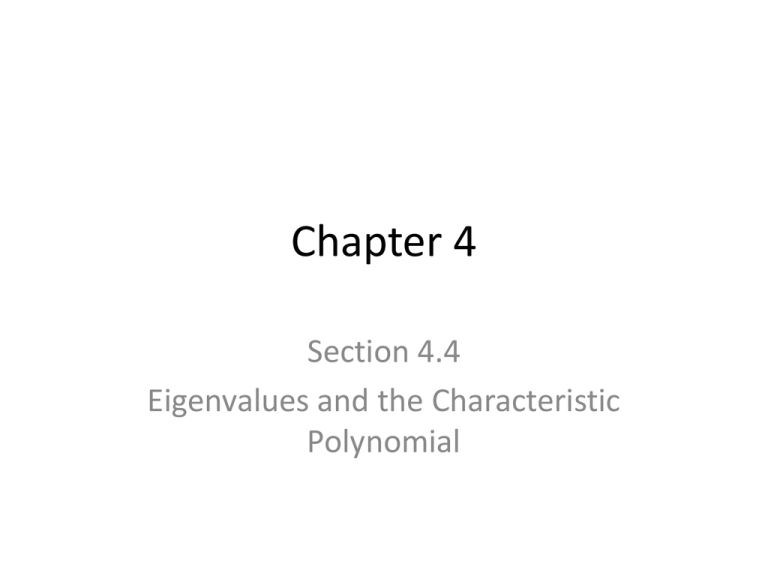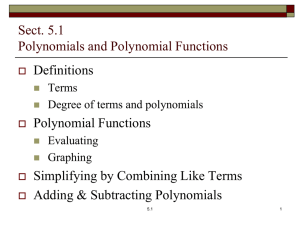Sec 4.4
advertisement

Chapter 4 Section 4.4 Eigenvalues and the Characteristic Polynomial Characteristic Polynomial If A is an 𝑛 × 𝑛 matrix the characteristic polynomial is a function of the variable t we call 𝑝 𝑡 that is the determinant of 𝐴 − 𝑡𝐼. 𝑝 𝑡 = det 𝐴 − 𝑡𝐼 Characteristic Equation If 𝑝 𝑡 is the characteristic polynomial of a matrix A, setting 𝑝 𝑡 = 0 is the characteristic equation of the matrix A. The solutions to this equation are the eigenvalues of matrix A. Example For the matrix A given to the right find its characteristic polynomial and its eigenvalues. 9 5 2 𝐴 = −10 −6 1 0 0 3 Since the 3rd row has two zeros we compute det 𝐴 − 𝑡𝐼 by expanding across the third row. 9−𝑡 −10 0 5 −6 − 𝑡 0 2 9−𝑡 1 = 3−𝑡 −10 3−𝑡 5 = 3−𝑡 −6 − 𝑡 9 − 𝑡 −6 − 𝑡 − −50 = 3 − 𝑡 𝑡 2 − 3𝑡 − 54 + 50 = 3 − 𝑡 𝑡 2 − 3𝑡 − 4 = 3 − 𝑡 𝑡 − 4 𝑡 + 1 Since the object of these problems is to find the roots of this polynomial we very often will leave the characteristic polynomial in factored form and do not multiply it out so we can tell what the solutions to 𝑝 𝑡 = 0 are by just looking at it. Characteristic Equation: 𝑝 𝑡 = 3 − 𝑡 𝑡 − 4 𝑡 + 1 Eigenvalues are: -1, 3, 4 Example Find the characteristic polynomial and the eigenvalues for the matrix A given to the right. (Sometimes called Fibonacci matrix.) Characteristic Polynomial is: 𝑝 𝑡 = det 𝐴 − 𝑡𝐼 = −𝑡 1 𝐴= 0 1 1 1 1 = −𝑡 1 − 𝑡 − 1 = 𝑡 2 − 𝑡 − 1 1−𝑡 This polynomial does not factor so use the quadratic formula to get 𝑡 = 1± 12 − −4 2 = 1± 5 2 If A is a 𝑛 × 𝑛 matrix and 𝑝 𝑡 = det 𝐴 − 𝑡𝐼 is the characteristic polynomial for A then 𝑝 𝑡 is a polynomial of degree n with the coefficient of 𝑡 𝑛 being ±1. Using algebraic methods to solve a general polynomial of degree n can be difficult (in fact, sometimes impossible), but there are some techniques that will often work. Factoring and Solving Polynomials If 𝑝 𝑡 = 𝑡 𝑛 + 𝑐𝑛−1 𝑡 𝑛−1 + ⋯ + 𝑐1 𝑡 + 𝑐0 is a polynomial with integer coefficients sometimes the following method will work for factoring the polynomial 𝑝 𝑡 . 1. Find the factors of the constant term 𝑐0 say they are ±1, ±𝑑1 , ⋯ ± 𝑑𝑘 . 2. Plug each factor into 𝑝 𝑡 till you find one that is zero say 𝑑𝑗 (i.e. 𝑝 𝑑𝑗 = 0), that means that 𝑡 − 𝑑𝑗 is one of the factors. 3. Use long division to find 𝑝 𝑡 ÷ 𝑡 − 𝑑𝑗 = 𝑞 𝑡 that means that 𝑝 𝑡 = 𝑡 − 𝑑𝑗 𝑞 𝑡 . This gives one factor of 𝑝 𝑡 . 4. Apply the same thing to 𝑞 𝑡 until you get down to degree 1 or 2 polynomial. Example 12 4 6 Find the characteristic polynomial and eigenvalues for the 𝐴 = −19 −6 −11 matrix A given to the right. −9 −4 −3 12 − 𝑡 4 6 𝑝 𝑡 = det 𝐴 − 𝑡𝐼 = −19 −6 − 𝑡 −11 −9 −4 −3 − 𝑡 Use a 1st −6 − 𝑡 −11 −19 −11 −19 −6 − 𝑡 column = 12 − 𝑡 −4 +6 −4 −3 − 𝑡 −9 −3 − 𝑡 −9 −4 expansion = 12 − 𝑡 −6 − 𝑡 −3 − 𝑡 − 44 − 4 19𝑡 + 57 − 99 + 6 76 − 54 + 9𝑡 then 2 = 12 − 𝑡 𝑡 + 9𝑡 + 18 − 44 − 4 19𝑡 − 42 + 6 −9𝑡 + 22 simplify 2 = 12 − 𝑡 𝑡 + 9𝑡 − 26 − 76𝑡 + 168 − 54𝑡 + 132 the 2 3 2 polynomial = 12𝑡 + 108𝑡 − 312 − 𝑡 − 9𝑡 + 26𝑡 − 130𝑡 + 300 = −𝑡 3 + 3𝑡 2 + 4𝑡 − 12 = − 𝑡 3 − 3𝑡 2 − 4𝑡 + 12 1. The constant term is 12, and the factors of 12 are: ± 1, ±2, ±3, ±4, ±6, ±12 2. Plugging in we get 𝑝 1 = −6, 𝑝 −1 = −12, 𝑝 2 = 0 𝑡2 − 𝑡 − 6 𝑡−2 𝑡 3 −3𝑡 2 −4𝑡+12 Use long division to get 𝑡−2 Now we know 𝑝 𝑡 = − 𝑡 − 2 𝑡 2 − 3. 4. 𝑡−6 5. Factor 𝑝 𝑡 = − 𝑡 − 2 𝑡 + 2 𝑡 − 3 The characteristic polynomial is: 𝑝 𝑡 = −𝑡 3 + 3𝑡 2 + 4𝑡 − 12 Eigenvalues are: −2,2,3 𝑡 3 − 3𝑡 2 − 4𝑡 + 12 − 𝑡 3 − 2𝑡 2 −𝑡 2 − 4𝑡 + 12 − −𝑡 2 + 2𝑡 −6𝑡 + 12 − −6𝑡 + 12 0 In general the problem of finding the characteristic polynomial and corresponding eigenvalues for a matrix can be very difficult. If the matrix has a certain pattern or contains a lot of zeros there are quick and easy ways to find the characteristic polynomial and eigenvalues. Characteristic Polynomials for Diagonal, Lower and Upper Triangular Matrices If 𝐴 = 𝑎𝑖𝑗 diagonal or triangular: 𝑝 𝑡 = 𝑎11 − 𝑡 𝑎22 − 𝑡 ⋯ 𝑎𝑛𝑛 − 𝑡 The characteristic polynomial of a diagonal, upper or lower triangular matrix 𝐴 = 𝑎𝑖𝑗 is the product of each factor 𝑎𝑖𝑖 − 𝑡 and the eigenvalues are the main diagonal entries. The Eigenvalues are: 𝑎11 , 𝑎22 , ⋯ , 𝑎𝑛𝑛 Example Find the characteristic polynomial and eigenvalues for the matrix A below to the right. 0 0 0 0 5 The matrix is upper triangular. 6 0 0 0 3 𝑝 𝑡 = 5 − 𝑡 8 − 𝑡 −1 − 𝑡 6 − 𝑡 2 𝐴 = −1 1 8 0 0 0 −2 4 −1 0 Eigenvalues: −1, 5, 6, 8 7 0 9 6 6 Example Find three different 3 × 3 upper triangular matrices whose only eigenvalues are 1 and 4. Give all the possibilities for the characteristic polynomial 1 ∗ ∗ 1 ∗ ∗ 1 ∗ ∗ 𝐶= 0 4 ∗ 𝐴= 0 1 ∗ 𝐵= 0 4 ∗ 0 0 1 0 0 4 0 0 4 Characteristic polynomial 𝑝 𝑡 = − 𝑡 − 1 2 𝑡 − 4 or 𝑝 𝑡 = − 𝑡 − 1 𝑡 − 4 2 The number of times an eigenvalue is a root of the characteristic equation will tell us some information about the matrix when it is compared to another number that will be discussed later. This number is important enough we give it a name. Algebraic Multiplicity If A is a 𝑛 × 𝑛 matrix and 𝑝 𝑡 is the characteristic polynomial of the matrix A (i.e. 𝑝 𝑡 = det 𝐴 − 𝑡𝐼 ) and 𝜆 is an eigenvalue for A, then 𝜆 − 𝑡 is a factor of the polynomial 𝑝 𝑡 and the number of times that 𝜆 − 𝑡 is a factor of 𝑝 𝑡 is called the algebraic multiplicity of the eigenvalue 𝜆. Algebraic multiplicity is the largest value 𝑘 such that: 𝑝 𝑡 = det 𝐴 − 𝑡𝐼 = 𝜆 − 𝑡 𝑘 𝑞 𝑡 Example For the 𝑛 × 𝑛 matrix to the right find the characteristic polynomial, all of the eigenvalues for the matrix along with the algebraic multiplicity of each of the eigenvalues that you found. The matrix A is diagonal so the characteristic polynomial is: 3 0 0 0 0 0 𝑝 𝑡 = 3−𝑡 7−𝑡 7−𝑡 3−𝑡 3−𝑡 3−𝑡 = 3−𝑡 0 7 0 0 0 0 4 0 0 0 3 0 0 0 0 7 0 0 0 7−𝑡 0 0 0 0 3 0 0 0 0 0 0 3 2 The algebraic multiplicity of the eigenvalue 3 is equal to 4. The eigenvalues for A are : 3,7 The algebraic multiplicity of the eigenvalue 7 is equal to 2. Example Find the characteristic polynomial and eigenvalues for the matrix A to the right. 5 𝐴= 0 0 0 6 8 0 0 1 7 1 3 2 4 3 1 Even though A is not triangular take advantage of the zeros in the first two columns. 6 1 2 5−𝑡 8−𝑡 7 4 8 − 𝑡 7 4 0 𝑝 𝑡 = = 5−𝑡 0 1−𝑡 3 0 1−𝑡 3 0 0 3 1−𝑡 0 3 1−𝑡 0 1−𝑡 3 = 5−𝑡 8−𝑡 = 5−𝑡 8−𝑡 1−𝑡 1−𝑡 −9 3 1−𝑡 = 5 − 𝑡 8 − 𝑡 𝑡 2 − 2𝑡 − 8 = 5−𝑡 8−𝑡 𝑡−4 𝑡+2 1st column expansion 2nd column expansion factor Characteristic polynomial 𝑝 𝑡 = 5 − 𝑡 8 − 𝑡 𝑡 − 4 𝑡 + 2 , Eigenvalues: −2, 4, 5, 8 Properties of the Characteristic Polynomial We will now look at a few of the more important properties of the characteristic polynomial of a matrix A. Characteristic Polynomials and Determinants The value of the characteristic polynomial at zero is the determinant of the matrix. If A is 𝑛 × 𝑛 matrix and 𝑝 𝑡 = det 𝐴 − 𝑡𝐼 then: 𝑝 0 = det 𝐴 = 𝐴 Evaluating Matrix Functions If you want to plug a 𝑛 × 𝑛 matrix A into a polynomial 𝑝 𝑡 (i.e. evaluate 𝑝 𝐴 ) this is done by replacing all constant terms 𝑐 by 𝑐𝐼 in the polynomial where 𝐼 is the 𝑛 × 𝑛 identity matrix. The rest of the polynomial is evaluated using ordinary matrix arithmetic. Being able to evaluate matrices in polynomials allows fro matrix functions trigonometric, exponential and logarithmic functions. Example For the matrix A to the right find the characteristic polynomial 𝑝 𝑡 then evaluate 𝑝 𝐴 . 2−𝑡 𝑝 𝑡 = 3 1 = −2 − 𝑡 2 − 𝑡 −2 − 𝑡 − 3 = 2 1 2 𝑝 𝐴 = 𝐴 − 7𝐼 = −7 3 −2 7 0 7 = − 0 7 7 2 𝑡2 −4−3= 𝐴= 𝑡2 −7 1 0 2 1 2 1 7 0 = − 0 1 3 −2 3 −2 0 7 0 0 0 = =𝒪 0 0 0 Evaluating a Matrix in its Characteristic Polynomial Its is always true that if you plug a matrix into its characteristic polynomial you will get the zero matrix. 2 3 1 −2 Characteristic Equation The result is the zero matrix ! If 𝑝 𝑡 = det 𝐴 − 𝑡𝐼 then: 𝑝 𝐴 =𝒪 This result has many applications. One in particular is a more efficient way to compute the inverse of a matrix than augmenting with the identity and row reducing. Example Find the characteristic polynomial of the matrix A to the right and use this to compute 𝐴−1 . 1 2 −2 𝐴 = 0 −1 4 0 0 2 Take advantage of the fact that the matrix A is upper triangular so : 𝑝 𝑡 = 1 − 𝑡 −1 − 𝑡 2 − 𝑡 = 𝑡 2 − 1 2 − 𝑡 = −𝑡 3 + 2𝑡 2 + 𝑡 − 2 𝑝 𝐴 =𝒪 −𝐴3 + 2𝐴2 + 𝐴 − 2𝐼 = 𝒪 −𝐴3 + 2𝐴2 + 𝐴 = 2𝐼 𝐴 −𝐴2 + 2𝐴 + 𝐼 = 2𝐼 1 𝐴 −𝐴2 + 2𝐴 + 𝐼 = 𝐼 2 𝐴 −12𝐴2 + 𝐴 + 12𝐼 = 𝐼 𝐴−1 𝐴−1 = = 1 −2 1 −2 1 0 0 1. The idea here is to move the constant times identity matrix to one side of the equation. 2. Factor the matrix A out from the other side. 3. Divide by the constant if not 1. 4. Collect all terms in factor other than A. 1 2 −2 1 2 −2 1 2 −2 1 0 0 1 0 −1 4 0 −1 4 + 0 −1 4 + 2 0 1 0 0 0 2 0 0 2 0 0 2 0 0 1 1 0 0 1 2 −3 2 0 2 1 2 −2 1 1 4 + 0 −1 4 + 0 2 0 = 0 −1 2 1 0 0 0 4 0 0 2 0 0 12 2 If 𝜆1 , ⋯ , 𝜆𝑘 eigenvalues for A then the eigenvalues for 𝐴2 are: 𝜆12 , ⋯ , 𝜆2𝑘 Eigenvalues and the Square of a Matrix If 𝜆 is an eigenvalue for the matrix A then 𝜆2 is an eigenvalue of the matrix 𝐴2 . The reason for this is as follows. Let v be the eigenvector corresponding to 𝜆. 𝐴2 𝐯 = 𝐴 ∙ 𝐴 𝐯 = 𝐴 𝐴𝐯 = 𝐴 𝜆𝐯 = 𝜆 𝐴𝐯 = 𝜆 ∙ 𝜆𝐯 = 𝜆2 𝐯 Eigenvalues and a Power of a Matrix This is true for any positive integer p, if 𝜆 is an eigenvalue for the matrix A then 𝜆𝑝 is an eigenvalue of the matrix 𝐴𝑝 . If 𝜆1 , ⋯ , 𝜆𝑘 eigenvalues for A then the eigenvalues for 𝐴𝑝 are: 𝑝 𝑝 𝜆1 , ⋯ , 𝜆𝑘 The reason for this is as follows. Let v be the eigenvector corresponding to 𝜆. 𝐴𝑝 𝐯 = 𝐴 ∙ ⋯ ∙ 𝐴 𝐯 = 𝐴 ∙ ⋯ ∙ 𝐴 𝐴𝐯 = 𝐴 ∙ ⋯ ∙ 𝐴 𝜆𝐯 = 𝜆 𝐴 ∙ ⋯ ∙ 𝐴 𝐯 = ⋯ = 𝜆𝑝 𝐯 𝑝 𝑡𝑖𝑚𝑒𝑠 𝑝−1 𝑡𝑖𝑚𝑒𝑠 𝑝−1 𝑡𝑖𝑚𝑒𝑠 Eigenvalues and a Function of a Matrix If 𝜆 is an eigenvalue for the matrix A and 𝑓 𝑡 is any polynomial then 𝑓 𝜆 is an eigenvalue of the matrix 𝑓 𝐴 . 𝑝−1 𝑡𝑖𝑚𝑒𝑠 If 𝜆1 , ⋯ , 𝜆𝑘 eigenvalues for A and 𝑓 𝑡 is a polynomial then the eigenvalues for 𝑓 𝐴 are: 𝑓 𝜆1 , ⋯ , 𝑓 𝜆𝑘 The reason for this is as follows. Let v be the eigenvector corresponding to 𝜆. Let the polynomial 𝑓 𝑡 = 𝑐𝑚 𝑡 𝑚 + ⋯ + 𝑐1 𝑡 + 𝑐0 . 𝑓 𝐴 𝐯 = 𝑐𝑚 𝐴𝑚 + ⋯ + 𝑐1 𝐴 + 𝑐0 𝐼 𝐯 = 𝑐𝑚 𝐴𝑚 𝐯 + ⋯ + 𝑐1 𝐴𝐯 + 𝑐0 𝐼𝐯 = 𝑐𝑚 𝜆𝑚 𝐯 + ⋯ + 𝑐1 𝜆𝐯 + 𝑐0 𝐯 = 𝑐𝑚 𝜆𝑚 + ⋯ + 𝑐1 𝜆 + 𝑐0 𝐯 = 𝑓 𝜆 𝐯 Example A 3 × 3 matrix A has eigenvalues of: − 1, 1, 3. Find the eigenvalues of the matrices 𝐴2 , 𝐴3 and 𝐴2 − 4𝐴 + 3𝐼. Eigenvalues of 𝐴2 − 4𝐴 + 3𝐼 are: −1 The eigenvalues of 𝐴2 are: −1 2 , 12 , 32 = 1,9 The eigenvalues of 𝐴3 are: −1 3 , 13 , 33 = −1,1,27 2 − 4 −1 + 3, 12 − 4 ∙ 1 + 3, 32 − 4 ∙ 3 + 3 = 0,7 Eigenvalues and the Inverse of a Matrix If 𝜆 is an eigenvalue for the matrix A then 𝜆1 is an eigenvalue of the matrix 𝐴−1 . If 𝜆1 , ⋯ , 𝜆𝑘 eigenvalues for A then the eigenvalues for 𝐴−1 are: 1 1 , ⋯ , 𝜆 𝜆 1 𝑘 The reason for this is as follows. Let v be the eigenvector corresponding to 𝜆 ≠ 0. 𝜆𝐴−1 𝐯 = 𝐴−1 𝜆𝐯 = 𝐴−1 𝐴𝐯 = 𝐴−1 𝐴 𝐯 = 𝐼𝐯 = 𝐯 divide by 𝜆: 𝐴−1 𝐯 = 𝜆1𝐯 Eigenvalues and the Transpose of a Matrix The characteristic equation 𝑝 𝑡 of a matrix A is equal to the characteristic equation 𝑞 𝑡 of the matrix 𝐴𝑇 . This means a matrix and its transpose will have the same eigenvalues. If 𝜆1 , ⋯ , 𝜆𝑘 eigenvalues for A then the eigenvalues for 𝐴𝑇 are: 𝜆1 , ⋯ , 𝜆𝑘 The characteristic equation of 𝐴 and 𝐴𝑇 are equal. The reason for this is as follows. Remember det 𝑀 = det 𝑀𝑇 and 𝐼 𝑇 = 𝐼. 𝑞 𝑡 = det 𝐴𝑇 − 𝑡𝐼 = det 𝐴𝑇 − 𝑡𝐼 𝑇 = det 𝐴 − 𝑡𝐼 𝑇 = det 𝐴 − 𝑡𝐼 = 𝑝 𝑡







